It was an odd feeling when I realized that I didn’t know the difference between a bluebird and a blue jay, but it’s something that I thought about for a while. Instead of remaining ignorant and wallowing in my misery, I decided to do something about it. I researched the topic thoroughly and I’ll share the results of my discovery with you right now.
Mixing up blue jays and bluebirds is easy because their plumages are very similar in color and they both have powerful singing voices. The nuances of their singing voices, the size, and shapes of their wings and bodies, and the variances between their colors and behaviors all showcase big differences.
And that’s just the beginning.
The main topics that I’ll cover include:
- The different sounds and songs coming from blue jays and bluebirds
- The varying sizes and shapes differing between the two
- The different color variations and patterns of their plumage
- The varying behavioral traits that showcase their differences
- The different habitats that each of these birds prefer
And I’ll squeeze in another fact or two for good measure!
I’d like to welcome you to the wonderful world of discovering the differences between bluebirds and blue jays.
If you’re ready to learn the truth, stick around and find out more below.
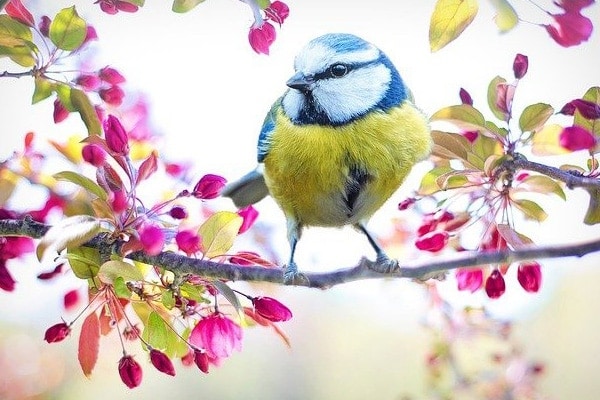
Sounds & Songs: The Variable Differences That Differentiate Bluebirds And Blue Jays
As far as differences go, bluebirds and blue jays definitely make diverse sounds from one another.
Really? Yes, it’s true.
Blue Jays
As far as blue jay calls are concerned:
Their calls tend to sound like warbling and whistled loud hissing sounds.
Want to know what’s even more interesting?
They love mimicking the sounds of hawks! And their displays become so aggressive at times that they’ll unintentionally snap their beaks when their hawk-like display is too intense and aggressive.
Bluebirds
As far as bluebirds are concerned, their vocalizations and tonality exude from their diaphragm in a quiet and soft whisper.
And even more important…
Their beautiful whispery voices spring forth a series of whines, clicks, whirrs, and chucks to create liquid notes for their beautiful songs.
You’ll hear the songs from bluebirds when they feel like singing for the world to enjoy. And their tunes typically last around 2 minutes before they eventually stop the music and call it quits.
The sounds and sounds emanating from eastern bluebirds have a warbling low pitch to the overall tone. You’ll hear this gorgeous winged creature singing short songs that basically consist of 1-3 notes.
They also tend to intersperse these notes with other harsher notes that sound like babbling chatter. You’ll hear these harsher tones interspersed between their whistles.
Guess what else?
Songs from the Eastern bluebird only last a total of two seconds. So, they obviously aren’t too excited about singing since their songs are so short.
As far as bluebird calls are concerned…
When compared to blue jays, the songs that come out of their beaks and the sounds that they make are conservative and very soft-spoken. Blue jays can be much more aggressive and louder than their bluebird counterparts.
Shapes & Sizes: Examining The Main Differences Between Blue Jays And Bluebirds
It shouldn’t surprise anyone to learn that bluebirds and blue jays have different shapes and sizes. The variations consist of height, weight, the shape and size of their heads, legs, stomachs, and thickness in appearance.
The differences consist of:
Bluebirds
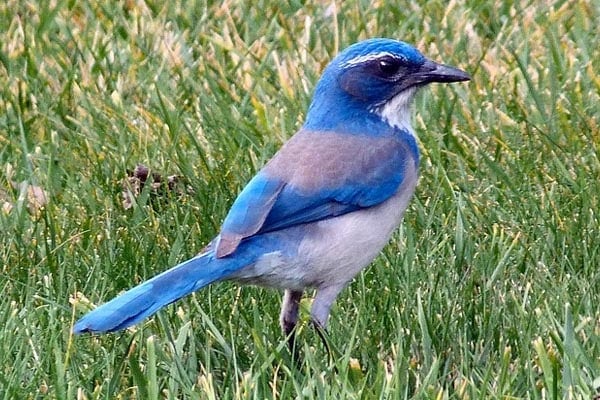
As far as height is concerned, a bluebird is typically anywhere between 6.5-8 inches long, which is definitely much shorter than a blue jay.
They also weigh a lot less than blue jays since their weight varies between 1-1.1 ounces, which isn’t very heavy at all.
For the shape of their body, many people tend to compare them to parakeets. Bluebirds have sleek chests and plump stomachs, which actually complement each other strangely enough.
Their heads are round and big, yet their legs and tails are very short. They also have short and straight beaks, which are very thin so they do not stand out prominently on their face.
Blue Jays
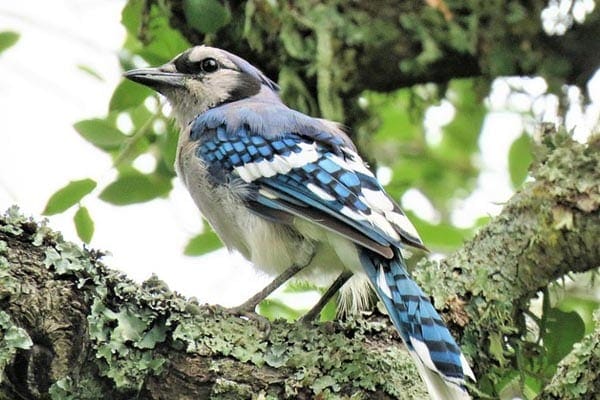
In the height department, a standard blue jay is roughly 11 inches tall, which is pretty large for wild birds.
In the weight category, the blue jay often ways between 2.5-4 ounces, which is nearly 3-4 times the size of a bluebird.
Their body shapes differ because blue jays have broad chests that protrude from their body and stick out quite a bit, and they also have very thick necks.
They have a 16-inch wingspan and very stout and thick beaks, which are much more prominent than bluebirds as well.
Oddly enough…
Their feet are the biggest giveaway and the major difference-maker that’ll help you see the difference between blue jays and bluebirds.
Blue jays have really long feet and tails. In fact, they even surpass thrush birds.
And as we mentioned earlier, bluebirds have short beaks, short tails, and short legs.
It’s these differences that make it easy to recognize one from the other.
Patterns & Colors: Variations In Their Plumage
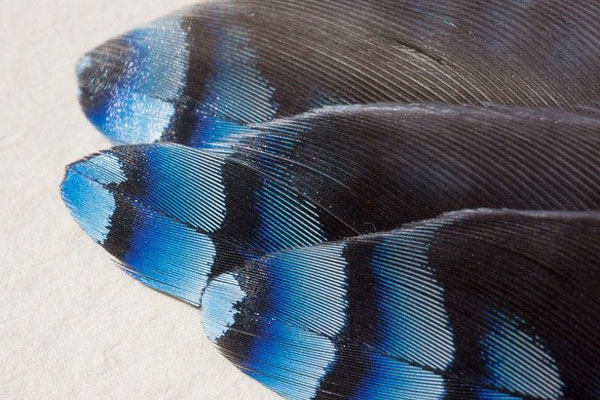
For the most part, Eastern bluebirds have small black beaks, brown feathers going underneath their neck and chest, and light or dark blue feathers on top of their head and wings.
These little guys also have brown strips of feathers that you can notice quite easily within their tails.
On the other hand:
Blue Jays actually have more noticeable colors interspersed throughout their feathers and other parts of their body. They are made up of black, brown, white, green, and blue shades.
And their feather patterns are even more interesting…
North American blue jays have black and blue stripes on their wings. Western blue jays, otherwise known as Steller’s jays, look unique because their head crest and plumage is black and dark blue.
And if you ever notice green coloration in their feathers or plumage patterns, you’re definitely looking at a blue jay as opposed to a bluebird.
The biggest difference between the two lies in the coloration of their chests. As I mentioned, bluebirds have brown feathers on their chests. Blue jays tend to have grayish-white feathers in the same area, which is noticeably different.
Behavioral Traits: The Biggest Differences In The Way Blue Jays And Bluebirds Act
From the standpoint of behavioral traits, bluebirds and blue jays definitely have their differences and they’re quite noticeable.
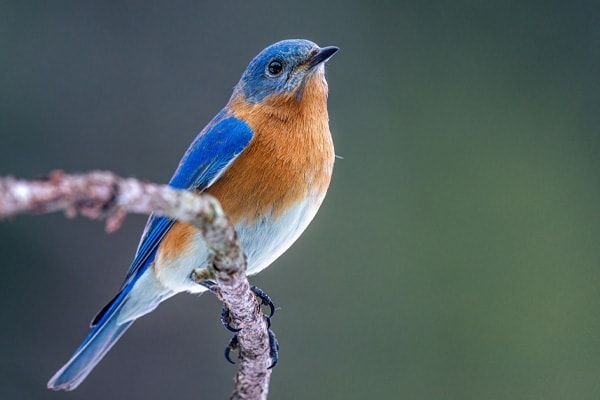
Bluebirds like to fly solo and remain fairly solitary. They do consort with other birds at times, and you can occasionally find them in small familiar groups or pairs. This usually happens as we near the conclusion of the breeding period.
On another note…
Bluebirds also have acute eyesight, which makes it easy for them to spot insects to eat as tasty meals. They do this from low shrubs or trees near the ground.
Blue jays tend to gather in flocks with their family, or you can find pairs of them flying around together. They like to stay with family because they must keep their nests safe, protected, and away from intruders – and this includes human beings as well.
What’s the biggest difference of all?
Blue jays are bullies, plain and simple. Bluebirds, on the other hand, are relatively docile creatures that hunt for seeds and insects instead of fighting with birds or other potentially dangerous animals.
Stomping Grounds: The Varying Locations For Bluebird And Blue Jay Habitats
Eastern bluebirds like to spend their time living in sparse woodlands and open fields. In fact, one of their favorite places to live are the edges of woodlands, near suburbia.
And speaking of suburbia…
When you see bluebirds in suburban locales, you’ll often find them on golf courses and open trails. That’s why it’s easy to find many of them in your neighborhood or the surrounding community.
Mountain bluebirds, on the other hand, enjoy living in high elevations of at least 7000 feet or more. During the summer, you can find them in the Alaskan mountains in the northwest.
Besides that, these birds enjoy living on the edges of sparse woodlands and open areas as well like mountain prairies and alpine meadows.
Switching things up:
Blue jays are usually found in the United States in the central or eastern regions. You’ll often discover blue jays in the Rocky Mountains, or on the Atlantic coast from southern Canada to Eastern Texas.
These bully birds find it easy to adapt to their environment. But overall, if they aren’t living in suburban areas with cities and parks, they’re usually spotted in forest-like settings.
Even more interesting:
Blue jays and bluebirds can be found in the same shared territories in different locations throughout the US. As a matter of fact, you’ll see both of these birds in many of the same states including:
- North Dakota
- South Dakota
- Texas
- Mexico
- Montana
- Washington
- Nevada
- Western Kansas
- Utah
- Idaho
- Western Nebraska
Concluding My Discovery Series About The Differences Between Bluebirds And Blue Jays
We finally made it to the end! And after performing thorough research, it was my pleasure to share the results of my discovery series with you today.
Most important of all, we learned that there are major differences between bluebirds and blue jays. At first, I thought the differences were going to be subtle, but as I dug deeper, I learned that there were big discrepancies between the two.
Some of the major differences between blue jays and bluebirds include:
- Blue jays have deeper resonant songs that are often more aggressive than bluebird songs and calls
- Some bluebirds are half the size of blue jays and weigh four times less in certain situations
- The major difference in the color of their feathers is that bluebirds have brown colored chests and blue jays have grayish white colored chests
- Behavioral traits vary and bluebirds often fly solo or pair with another bird, while blue jays remain in familial flocks especially during breeding season
- Although they share many of the same habitats, blue jays prefer denser forests while bluebirds like sparse woods in suburbia
Although these birds seem to appear the same, today we learned that they have many differences. You shouldn’t have trouble spotting the differences between the two any longer!
The post What Is The Difference Between A Bluebird And A Blue Jay? appeared first on BirdInformer.com.
from BirdInformer.com https://ift.tt/3t9EDzu

No comments:
Post a Comment